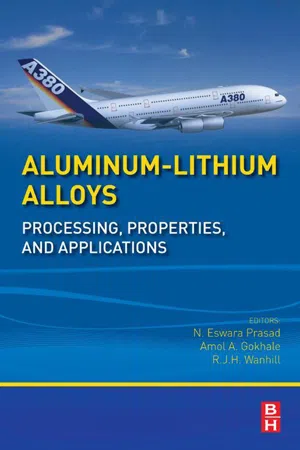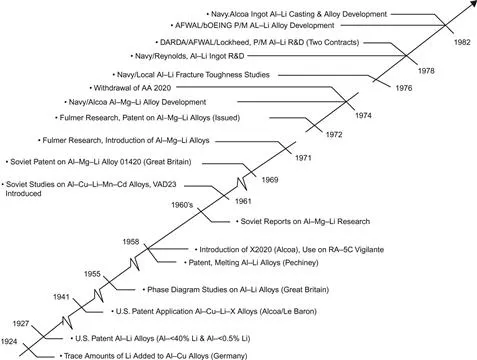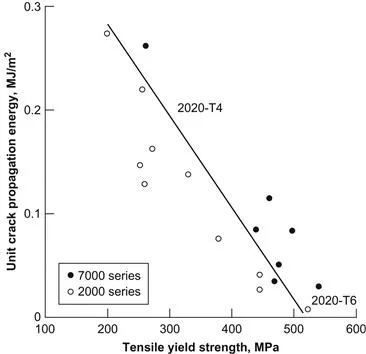![]()
Part I
Introduction to Al–Li Alloys
Outline
Chapter 1 Historical Development and Present Status of Aluminum–Lithium Alloys
Chapter 2 Aerostructural Design and Its Application to Aluminum–Lithium Alloys
![]()
Chapter 1
Historical Development and Present Status of Aluminum–Lithium Alloys
Edgar A. Starke Jr., Department of Materials Science and Engineering, University of Virginia, Charottesville, USA
This chapter provides a brief overview and history of the development of aluminium-lithium alloys from the earlier days of the discovery of age hardening by Alfred Wilm to its current status. It examines the progress of alloy development from simple binary alloys to the complex alloys that are currently used in aerospace systems. The driving force for this development has been the advantages gained by weight reduction of aerospace systems by replacing conventional aluminium alloys with the lower density higher modulus aluminium-lithium alloys. The problems associated with the development of these alloys and the scientific solutions to solving these problems are described.
Keywords
Al–Li alloys; history; precipitation; age hardening; deformation; ductility
Contents
1.1 Introduction
1.2 Lithium Additions to Aluminum Alloys: Early Days
1.2.1 History of the Development of the First Modern Al–Li Alloys
1.2.2 Development of Alcoa’s 2020
1.2.3 The Ductility Problem of 2020
1.2.4 Development of Al–Li Alloys in the Soviet Union
1.3 Development of Modern Aluminum–Lithium Alloys
1.3.1 The Second Generation of Aluminum–Lithium Alloys
1.3.2 Manufacturing Issues
1.3.3 Understanding the Precipitate Structure in Al–Li–X Alloys
1.3.4 The Effect of Prior Deformation on Precipitation During Ageing
1.3.5 Deformation Behavior in Aged Al–Li–X Alloys
1.3.6 Predicting Strain Localization in Al–Li–X Alloys
1.3.7 Applications and Problems of the Second-Generation Al–Li Alloys
1.3.8 The Third Generation of Aluminum–Lithium Alloys
1.3.9 Background Information That Led to Improvements in Al–Li–X Alloys
1.4 Closure
Acknowledgments
References
1.1 Introduction
Although “age hardening” was discovered in 1902 by Alfred Wilm at the Center for Scientific Research in Germany (Wilm, 1911), it was not until 1919 that the phenomenon of “age hardening” was explained (Starke and Hornbogen, 2008). Merica et al. (1919) were conducting research on Wilm’s alloy duralumin at the National Bureau of Standards in the United States and concluded that the cause of age hardening was due to precipitation from a supersaturated solid solution. They also stated that the key step in the process was a decrease in solid solubility of alloying elements with decreasing temperature and speculated that quenching from the high temperature and ageing at a lower temperature would produce a very fine dispersion of small particles within the matrix. They then introduced the idea of a critical particle size associated with maximum strengthening but made no attempt to describe how these particles resulted in the strength increase. Later, Jeffries and Archer (1921) proposed that the very fine particles formed during ageing interfered with the slip process. They recognized the crystallographic nature of slip and therefore supported the ideas proposed by Merica and his colleagues. These ideas led to searches for other alloys which could age harden, notably in the United States, Germany, and Japan in the 1920s and 1930s.
1.2 Lithium Additions to Aluminum Alloys: Early Days
Around the same time that Merica and his colleagues were explaining the phenomenon of age hardening, researchers in Germany were exploring aluminum alloys containing lithium. Considering the high solubility of lithium in aluminum at high temperatures and its decreasing solubility as the temperature is lowered, it is not surprising that lithium additions were included in these investigations. Balmuth and Schmidt (1980) discussed this work in their overview of the early development of aluminum–lithium alloys that they presented at the First International Aluminum–Lithium Conference held at Stone Mountain, GA. The first commercial aluminum alloy containing lithium was the German alloy “Scleron” that had a nominal composition of Al–12Zn–3Cu–0.6Mn–0.1Li (Reuleaux, 1924). The claims of the alloy were that it had great resistance to wear, relative cheapness, high tensile strength and resistance to corrosion and oxidation, and was superior to other aluminum alloys because it could be worked into a wide variety of forms. However, research by Assmann (1926) on the strengthening effect of lithium additions to aluminum was inconclusive, and other aluminum alloys that did not contain lithium showed better properties, so Scleron production was discontinued.
The development of modern aluminum–lithium alloys can be traced to the discovery by I.M. LeBaron in 1942 that lithium could be a major strengthening element in aluminum–copper alloys. LeBaron was granted a patent on Al–Cu–Li–Mn–Cd alloys in 1945 (LeBaron, 1945). However, the introduction of 7075 by Alcoa in 1943 established the dominance of the Al–Zn–Mg–Cu system for high-strength applications, and further work on LeBaron’s alloys were discontinued at that time. Subsequent work by Hardy and Silcock in England identified the lithium-containing strengthening phases in Al–Cu–Li alloys, and their research led to an increased interest in the alloy system (Hardy, 1955–56; Hardy and Silcock, 1955–56; Silcock, 1959–60). Hardy and Silcock contributed significantly to the scientific understanding of these complex materials.
1.2.1 History of the Development of the First Modern Al–Li Alloys
An abbreviated history of the use of lithium in aluminum alloys up to 1982 is shown in Figure 1.1 (Quist et al., 1983). A number of important events not noted in Figure 1.1 include the substantive contributions of several universities, funding agencies, and research laboratories.
Figure 1.1 Chronological early development and use of lithium in aluminum.
1.2.2 Development of Alcoa’s 2020
In the 1950s, metallurgists at Alcoa recognized that lithium also increased the elastic modulus of aluminum and developed the high strength Al–Cu–Li alloy 2020 in 1957 (Criner, 1957, 1959). The nominal composition of 2020 was Al–4.5Cu–1.1Li–0.5Mn–0.2Cd, and in addition to high strength at 300–400°F (~150–200°C), it was claimed that the alloy was resistant to creep at these temperatures. Subsequently, 2020 was commercially produced and used on the United States Navy RA 5C Vigilante aircraft. It performed well for over 20 years without any documented failures (Balmuth and Schmidt, 1980). Aluminum–lithium alloys are attractive for aerospace applications because they have lower density and higher modulus than conventional aluminum aerospace alloys. Each weight percent of lithium lowers the density of aluminum by approximately 3% and increases the modulus by approximately 6% (Starke and Staley, 1996). However, the perceived brittleness of 2020 and the production problems thwarted further use, and it was withdrawn from commercial production in the 1960s. A plot of contemporary data reveals that, although the 2020-T6 may have exhibited low toughness, it was being used in a very strong condition and was not dissimilar in its relative performance to other high-strength aerospace alloys of that period (Figure 1.2) (Peel, 1990).
Figure 1.2 Toughness of 2020 alloy in the T4 and T6 tempers in comparison to contemporary 1960s aerospace alloys (Peel, 1990).
1.2.3 The Ductility Problem of 2020
The iron and silicon contents of a typical 2020 alloy were relatively high when compared to modern aerospace alloys. During ingot solidification and subsequent processing these impurities precipitate as the insoluble constituent phases Al12(FeMn)3Si and Al7Cu2Fe, which vary in size from 1 to 10 μm (Starke and Staley, 1996). The detrimental effect of large constituent phases on the ductility and fracture toughness of aluminum alloys was first identified in 1961 (Anderson and Quist, 1966; Quist, 1963) and documented by many investigators (Smith, 1991). Not only do these large particles initiate cracks, but they also produce an inhomogeneous strain distribution during working operations, which enhances the possibility of recrystallization during subsequent heat treatments (Cotterill and Mold, 1976). Alloy 2020 had...


